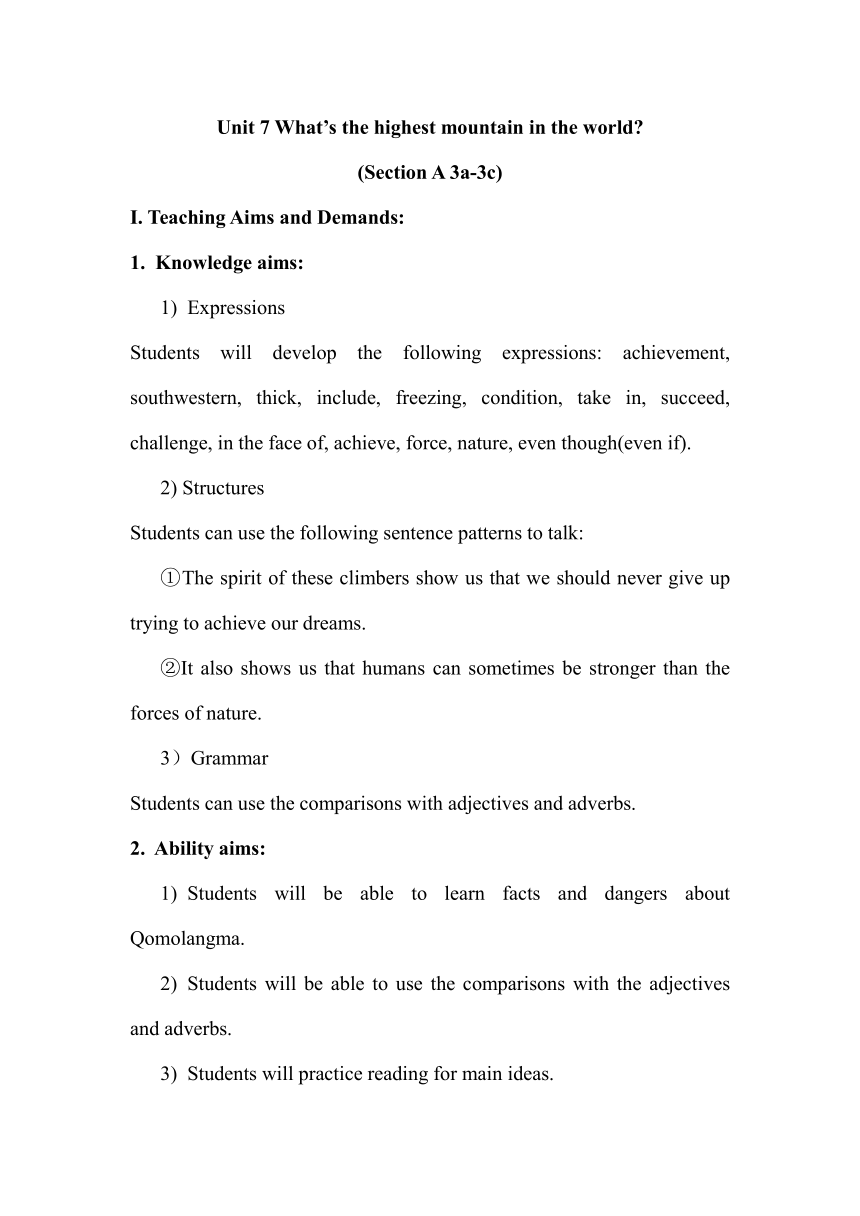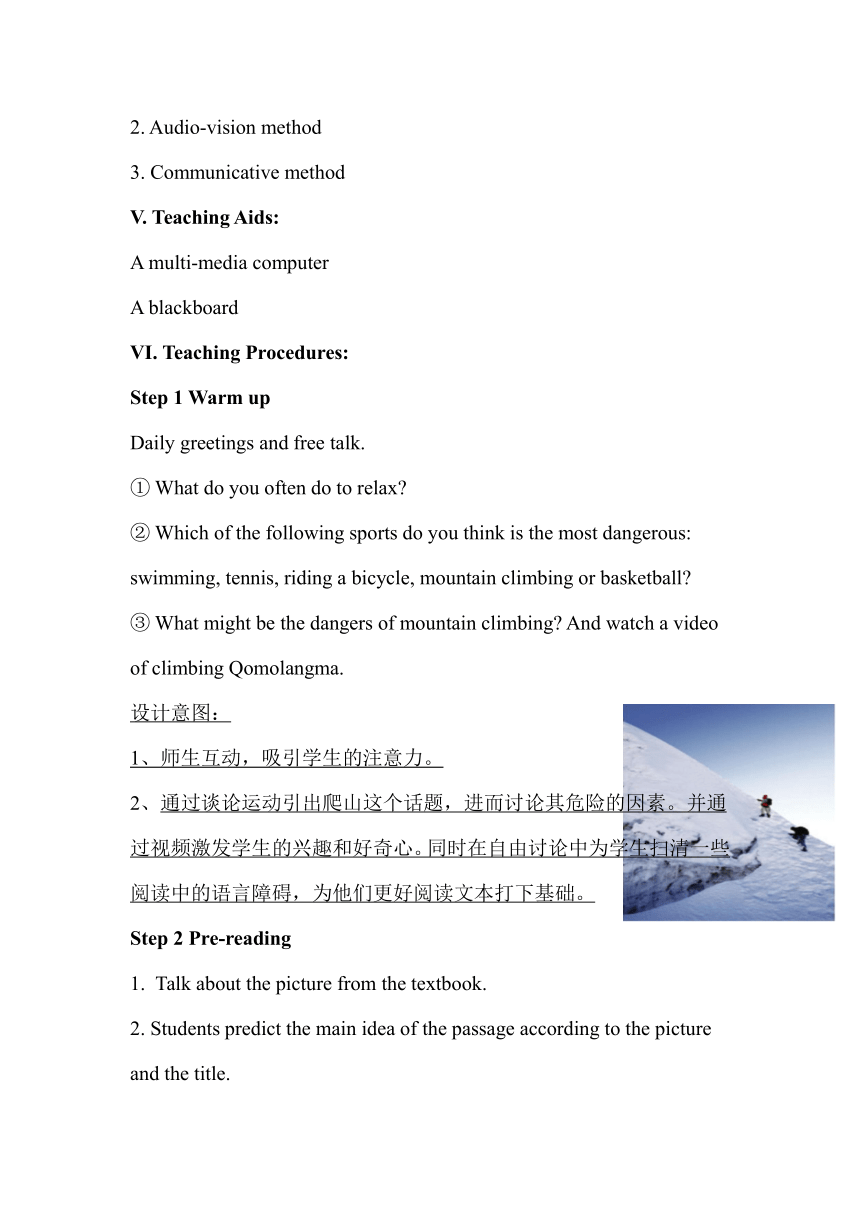人教版八年级下册 Unit7 What's the highest mountain in the world? SectionA 3a-3c 教案
文档属性
| 名称 | 人教版八年级下册 Unit7 What's the highest mountain in the world? SectionA 3a-3c 教案 |

|
|
| 格式 | doc | ||
| 文件大小 | 655.5KB | ||
| 资源类型 | 教案 | ||
| 版本资源 | 人教新目标(Go for it)版 | ||
| 科目 | 英语 | ||
| 更新时间 | 2022-12-30 23:25:58 | ||
图片预览



文档简介
Unit 7 What’s the highest mountain in the world
(Section A 3a-3c)
I. Teaching Aims and Demands:
1. Knowledge aims:
1) Expressions
Students will develop the following expressions: achievement, southwestern, thick, include, freezing, condition, take in, succeed, challenge, in the face of, achieve, force, nature, even though(even if).
2) Structures
Students can use the following sentence patterns to talk:
①The spirit of these climbers show us that we should never give up trying to achieve our dreams.
②It also shows us that humans can sometimes be stronger than the forces of nature.
3)Grammar
Students can use the comparisons with adjectives and adverbs.
2. Ability aims:
1) Students will be able to learn facts and dangers about Qomolangma.
2) Students will be able to use the comparisons with the adjectives and adverbs.
3) Students will practice reading for main ideas.
4) Students will be able to know the spirit of the climbers and use them in their lives.
3. Moral aims:
To help students develop the awareness that we should never give up and believe that humans can challenge themselves.
II. Analysis of students:
The students learned the comparisons in 8A so they have got certain basic knowledge.
In this unit, it is to extend and further develop the usage of the comparatives and superlatives of adjectives and adverbs.
III. Teaching Important & Difficult Points:
1. Teaching important points
1) Students will be able to learn facts and dangers about Qomolangma.
2)Students will be able to use the comparisons with the adjectives and adverbs.
3)Students will practice reading for main ideas.
2. Teaching difficult points
1) Ss will feel a bit difficult to pronouce some names and words in a passage.
2) It’s a bit difficult for students to use the reading skills while reading.
IV. Teaching Methods:
1. Task-based procedure
2. Audio-vision method
3. Communicative method
V. Teaching Aids:
A multi-media computer
A blackboard
VI. Teaching Procedures:
Step 1 Warm up
Daily greetings and free talk.
① What do you often do to relax
② Which of the following sports do you think is the most dangerous: swimming, tennis, riding a bicycle, mountain climbing or basketball
③ What might be the dangers of mountain climbing And watch a video of climbing Qomolangma.
设计意图:
1、师生互动,吸引学生的注意力。
2、通过谈论运动引出爬山这个话题,进而讨论其危险的因素。并通过视频激发学生的兴趣和好奇心。同时在自由讨论中为学生扫清一些阅读中的语言障碍,为他们更好阅读文本打下基础。
Step 2 Pre-reading
1. Talk about the picture from the textbook.
2. Students predict the main idea of the passage according to the picture and the title.
What’s the passage about
Qomolangma—— the Most Dangerous Mountain in the World
设计意图:
根据文章的插图和标题预测文章内容,这是阅读技巧的指导渗透,帮助学生提高阅读理解能力。
Step 3 While-reading
1. Fast reading:
Read the passage after the recording and find out the new words together.
Then match each paragraph with the main ideas.
2. Careful reading: Read each paragraph and finish the tasks.
Explain some words and pay attention to some pronunciations.
(1) Facts ans Dangers:___________
___________
___________
__________
_________
___________
(2)Fill in the table.
Time Achievements
1953 The first people to reach the top.(Tenzing Norgay and Edmund Hillary)
1960 The first Chinese team reached the top.
1975 The first woman to succeed.(Jungko Tabei)
(3) Read and list the comparisons
__________
___________
__________
_________
___________
3. Read aloud:Read the passage with the recording.
4. Fill in: fill in the blanks according to the passage.
One of the most popular places for mountain climbing is the Himalayas. They run along the ____________ part of China. Of all the mountains, Qomolangma rises the ________ (high) and is very __________(danger) to climb. Thick clouds cover the top and snow can fall very hard. Even ____________(serious) difficulties include ________(freeze) weather conditions and heavy storms. It is also very hard to take _____ air as you get near the top.
The first people to reach the top were Tenzing Norgan and Edmund Hillary. The first Chinese team did so in 1960. The first woman to ________(success) was Junko Tabei in 1975.
Many people want to __________(challenge) themselves in the face of difficulties , so they try to climb Qomolangma. It tells us that we should never give up ______ (try) to achieve our dreams. It also shows that humans can sometimes be stronger than the _______ (force) of nature.
设计意图:
1、多种阅读技巧的指导,提高学生的阅读能力。
2、跟读磁带,模仿语音语调,夯实学生的语言基础。
3、根据课文内容填空,提高学生的语言应用能力。
Step 4 Post-reading
1. Discussion: Students discuss and share their opinions to the question why is it a question mark in the title
2: Free talk: Students tell about their future jobs and ask for advice to overcome the “Qomolangma” they are facing.
设计意图:
1、论标题中的问号使用在于帮助学生深层次理解作者的写作意图,加深对文章的理解。
2、师生自由对话活动在于联系实际,解决学生的实际生活问题,培养学生坚持梦想,挑战自我的不服输的精神。
Step 5 Sum up
Guide students to sum up what they have learned and what they can get from the article.
设计意图:
1、总结复习本节课所学。
2、德育的渗透,深化文本的内涵。
VII. Evaluation:
Students are active in the class.
VIII.. Blackboard Design:
Paragraph 1 Spirit of climbers
Paragraph 2 Achievements of climbers
Paragraph 3 Facts and dangers
include achievement
southwestern challenge
freezing succeed
Unit 7
What’s the highest mountain in the world
Section A 3a-3c
Para.1 Facts and dangers
Para.2 Achievements of climbers
Para.3 Spirit of climbers
(Section A 3a-3c)
I. Teaching Aims and Demands:
1. Knowledge aims:
1) Expressions
Students will develop the following expressions: achievement, southwestern, thick, include, freezing, condition, take in, succeed, challenge, in the face of, achieve, force, nature, even though(even if).
2) Structures
Students can use the following sentence patterns to talk:
①The spirit of these climbers show us that we should never give up trying to achieve our dreams.
②It also shows us that humans can sometimes be stronger than the forces of nature.
3)Grammar
Students can use the comparisons with adjectives and adverbs.
2. Ability aims:
1) Students will be able to learn facts and dangers about Qomolangma.
2) Students will be able to use the comparisons with the adjectives and adverbs.
3) Students will practice reading for main ideas.
4) Students will be able to know the spirit of the climbers and use them in their lives.
3. Moral aims:
To help students develop the awareness that we should never give up and believe that humans can challenge themselves.
II. Analysis of students:
The students learned the comparisons in 8A so they have got certain basic knowledge.
In this unit, it is to extend and further develop the usage of the comparatives and superlatives of adjectives and adverbs.
III. Teaching Important & Difficult Points:
1. Teaching important points
1) Students will be able to learn facts and dangers about Qomolangma.
2)Students will be able to use the comparisons with the adjectives and adverbs.
3)Students will practice reading for main ideas.
2. Teaching difficult points
1) Ss will feel a bit difficult to pronouce some names and words in a passage.
2) It’s a bit difficult for students to use the reading skills while reading.
IV. Teaching Methods:
1. Task-based procedure
2. Audio-vision method
3. Communicative method
V. Teaching Aids:
A multi-media computer
A blackboard
VI. Teaching Procedures:
Step 1 Warm up
Daily greetings and free talk.
① What do you often do to relax
② Which of the following sports do you think is the most dangerous: swimming, tennis, riding a bicycle, mountain climbing or basketball
③ What might be the dangers of mountain climbing And watch a video of climbing Qomolangma.
设计意图:
1、师生互动,吸引学生的注意力。
2、通过谈论运动引出爬山这个话题,进而讨论其危险的因素。并通过视频激发学生的兴趣和好奇心。同时在自由讨论中为学生扫清一些阅读中的语言障碍,为他们更好阅读文本打下基础。
Step 2 Pre-reading
1. Talk about the picture from the textbook.
2. Students predict the main idea of the passage according to the picture and the title.
What’s the passage about
Qomolangma—— the Most Dangerous Mountain in the World
设计意图:
根据文章的插图和标题预测文章内容,这是阅读技巧的指导渗透,帮助学生提高阅读理解能力。
Step 3 While-reading
1. Fast reading:
Read the passage after the recording and find out the new words together.
Then match each paragraph with the main ideas.
2. Careful reading: Read each paragraph and finish the tasks.
Explain some words and pay attention to some pronunciations.
(1) Facts ans Dangers:___________
___________
___________
__________
_________
___________
(2)Fill in the table.
Time Achievements
1953 The first people to reach the top.(Tenzing Norgay and Edmund Hillary)
1960 The first Chinese team reached the top.
1975 The first woman to succeed.(Jungko Tabei)
(3) Read and list the comparisons
__________
___________
__________
_________
___________
3. Read aloud:Read the passage with the recording.
4. Fill in: fill in the blanks according to the passage.
One of the most popular places for mountain climbing is the Himalayas. They run along the ____________ part of China. Of all the mountains, Qomolangma rises the ________ (high) and is very __________(danger) to climb. Thick clouds cover the top and snow can fall very hard. Even ____________(serious) difficulties include ________(freeze) weather conditions and heavy storms. It is also very hard to take _____ air as you get near the top.
The first people to reach the top were Tenzing Norgan and Edmund Hillary. The first Chinese team did so in 1960. The first woman to ________(success) was Junko Tabei in 1975.
Many people want to __________(challenge) themselves in the face of difficulties , so they try to climb Qomolangma. It tells us that we should never give up ______ (try) to achieve our dreams. It also shows that humans can sometimes be stronger than the _______ (force) of nature.
设计意图:
1、多种阅读技巧的指导,提高学生的阅读能力。
2、跟读磁带,模仿语音语调,夯实学生的语言基础。
3、根据课文内容填空,提高学生的语言应用能力。
Step 4 Post-reading
1. Discussion: Students discuss and share their opinions to the question why is it a question mark in the title
2: Free talk: Students tell about their future jobs and ask for advice to overcome the “Qomolangma” they are facing.
设计意图:
1、论标题中的问号使用在于帮助学生深层次理解作者的写作意图,加深对文章的理解。
2、师生自由对话活动在于联系实际,解决学生的实际生活问题,培养学生坚持梦想,挑战自我的不服输的精神。
Step 5 Sum up
Guide students to sum up what they have learned and what they can get from the article.
设计意图:
1、总结复习本节课所学。
2、德育的渗透,深化文本的内涵。
VII. Evaluation:
Students are active in the class.
VIII.. Blackboard Design:
Paragraph 1 Spirit of climbers
Paragraph 2 Achievements of climbers
Paragraph 3 Facts and dangers
include achievement
southwestern challenge
freezing succeed
Unit 7
What’s the highest mountain in the world
Section A 3a-3c
Para.1 Facts and dangers
Para.2 Achievements of climbers
Para.3 Spirit of climbers
同课章节目录
- Unit 1 What's the matter?
- Section A
- Section B
- Unit 2 I'll help to clean up the city parks.
- Section A
- Section B
- Unit 3 Could you please clean your room?
- Section A
- Section B
- Unit 4 Why don't you talk to your parents?
- Section A
- Section B
- Unit 5 What were you doing when the rainstorm came
- Section A
- Section B
- Review of Units 1-5
- Unit 6 An old man tried to move the mountains.
- Section A
- Section B
- Unit 7 What's the highest mountain in the world?
- Section A
- Section B
- Unit 8 Have you read Treasure Island yet?
- Section A
- Section B
- Unit 9 Have you ever been to a museum?
- Section A
- Section B
- Unit 10 I've had this bike for three years.
- Section A
- Section B
